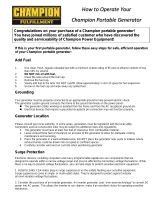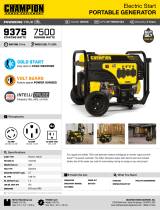
100892 - 4500W OPEN FRAME INVERTER
OPERATION
18
NOTICE
The generator engine works well with 10% or less ethanol
blend gasoline. When using ethanol-gasoline blends there are
some issues worth noting:
– Ethanol-gasoline blends can absorb more water than
gasoline alone.
– These blends can eventually separate, leaving water or
a watery goo in the tank, fuel valve and carburetor. The
compromised gasoline can be drawn into the carburetor
and cause damage to the engine and/or potential hazards.
– If a fuel stabilizer is used, confirm that it is formulated to
work with ethanol-gasoline blends.
– Any damages or hazards caused by using improper
gasoline, improperly stored gasoline, and/or improperly
formulated stabilizers, are not covered by manufacturer’s
warranty.
It is advisable to always shut off the gasoline supply and
run the engine to starvation after each use. See Storage
instructions for extended non-use.
Grounding
Your generator must be properly connected to an appropriate
ground to help prevent electric shock.
WARNING
Failure to properly ground the generator can result in electric
shock.
A ground terminal connected to the frame of the generator has
been provided (see Controls and Features for terminal location).
For remote grounding, connect of a length of heavy gauge
(12 AWG minimum) copper wire between the generator ground
terminal and a copper rod driven into the ground. We strongly
recommend that you consult with a qualified electrician to ensure
compliance with local electrical codes.
Neutral Floating*
– Neutral circuit IS NOT electrically connected to the frame/
ground of the generator.
– The generator (stator winding) is isolated from the frame and
from the AC receptacle ground pin.
– Electrical devices that require a grounded receptacle pin
connection will not function if the receptacle ground pin is not
functional.
Neutral Bonded to Frame*
– Neutral circuit IS electrically connected to the frame/ground of
the generator.
– The generator system ground connects lower frame cross-
member below the alternator. The system ground is connected
to the AC neutral wire.
* See your Specifications section for specified type of grounding.
OPERATION
Generator Location
NEVER operate the generator inside any building, including
garages, basements, crawlspaces and sheds, enclosure or
compartment, including the generator compartment of a
recreational vehicle. Please consult your local authority. In
some areas, generators must be registered with the local utility.
Generators used at construction sites may be subject to additional
rules and regulations. Generators should be on a flat, level surface
at all times. (Even while not in operation) Generators must have
at least 5 ft. (1.5 m) of clearance from all combustible material.
In addition to clearance from all combustible material, generators
must also have at least 3 ft. (91.4 cm) of clearance on all sides to
allow for adequate cooling, maintenance and servicing. Generators
should never be started or operated in the back of a SUV, camper,
trailer, in the bed of a truck (regular, flat or otherwise), under
staircases/stairwells, next to walls or buildings, or in any other
location that will not allow for adequate cooling of the generator
and/or the muffler. DO NOT contain generators during operation.
Allow generators to properly cool before transport or storage.
Place the generator in a well-ventilated area. DO NOT place the
generator near vents or intakes where exhaust fumes could be
drawn into occupied or confined spaces. Carefully consider wind
and air currents when positioning generator.
Failure to follow proper safety precautions may void
manufacturer’s warranty.
WARNING
Do not operate or store the generator in rain, snow, or wet
weather.
Using a generator or electrical appliance in wet conditions,
such as rain or snow, or near a pool or sprinkler system,
or when your hands are wet, could result in electrocution.
WARNING
During operation the muffler and exhaust fumes will become
hot. If adequate cooling and breathing space are not supplied,
or if the generator is blocked or enclosed, temperatures can
become extremely heated and may lead to fire.






























